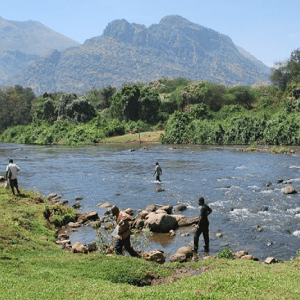
Building a Grassroots Constituency to Conserve the River Moyar in the Mysore-Nilgiri Corridor
Social Assessment to ensure compliance to CEPF Policy on Indigenous People
We proposed the project titled ‘Building a Grassroots Constituency to Conserve the River Moyar in the Mysore-Nilgiri Corridor on the premise that conservation programmes in the region have until date largely been perfunctory. We also found it ideal to propose a programme that takes a landscape approach rather be constrained by a politically or administratively defined unit, to ensure that the coverage is vast and uniform. The third and the most important factor that motivated us to propose this project is the fact that conservation research or programmes in the proposed project area have hitherto been very scarce in studying or involving human communities. It needs to be mentioned though that there have been a number of anthropological inquiries on the indigenous communities of the Nilgiris, largely during the Colonial period.
The proposed project design which takes the course of River Moyar as the deciding factor, covers at least five panchayats (decentralized grass root level planning and administrative units). This coverage though is not uniform. While the three panchayats viz Masinagudi, Mudumalai and Sholur would be most critical, the other two cover the fringe areas.
In-depth demographic studies of the three panchayats have not been carried out in the past; our preliminary assessment suggests that the landscape is home to the following broad categories of humans viz.
- Early settlers – largely during Pre-Colonial period who are now under the scheduled caste category of backward and most backward residing as homogenous units
- Recent settlers – mostly migrants in search of livelihoods
- Recent settlers – tribal communities – mostly communities in search of livelihood opportunities, landless labour and communities displaced from adjacent districts.
- Scheduled Tribes / Indigenous tribal communities – the original residents of the landscape, a number of endogamous groups. Notable for their involvement in the protection of the landscape. View themselves as custodians of the forest. Strong presence of customary rights and regulation in the use of natural resources. Notable are the Kurumbas (and their four sub-groups) and Irulars. Scheduled Tribes.
- The Scheduled Caste communities – considered the lowest in caste hierarchy. Not recognized by any past intervention in the landscape.
In view of the above, and also the past experience of working in other landscapes we propose the following:
The key outcome of the proposed project is the micro-plan, taking into consideration the following aspects:
- the project will not propose or create new jobs or provide dole in any form
- the project will recognize traditional and local institutions where indigenous and tribal communities are represented
- the project will ensure that no community is excluded because of their caste or tribal identity
- the project will ensure that marginal groups within the communities such as women are represented strongly.
- the project will attempt to understand and incorporate local cultural beliefs and norms for micro planning and will not seek to alter the same.
The project will be implemented only after consultations are held at the field level. These will be facilitated by the Gram sabha (an entity that is strictly voluntary and representative of all the communities) and the elected panchayat.
The proceedings of these consultations will be developed into mutual agreements.
The project will be jointly implemented with the Gram sabha and the panchayat. And as detailed in the proposal, it will be subjected to local review.
The Gram Sabha and the elected Panchayat for each community where the project will be implemented will function as a grievance mechanism for Indigenous People or other local communities who have any concerns or grievances about the project to raise them with the project team. In the unlikely event that a grievance is raised, Arulagam will ask the relevant Gram Sabha or Panchayat to convene a meeting between the project team and the affected parties, in order to resolve the conflict.
Arulagam will seek to hold these meetings within one month of any grievance being communicated to them. Any grievance raised will be communicated to CEPF, together with minutes from the meeting held to address them, plus a detailed plan of remedial action.
Long term sustainability of the project will be ensured will the project team working closely with the Gram Sabha and the Panchayat to develop proposals for the consideration of the State and Central Government, Other Non governmental organizations and Donor Agencies.
As a collaborative group of institutions striving to reconcile conservation and development goals, we appreciated the safeguards policy of CEPF and shall strive to adhere to all the issues/concerns and terms listed in the policy document.
